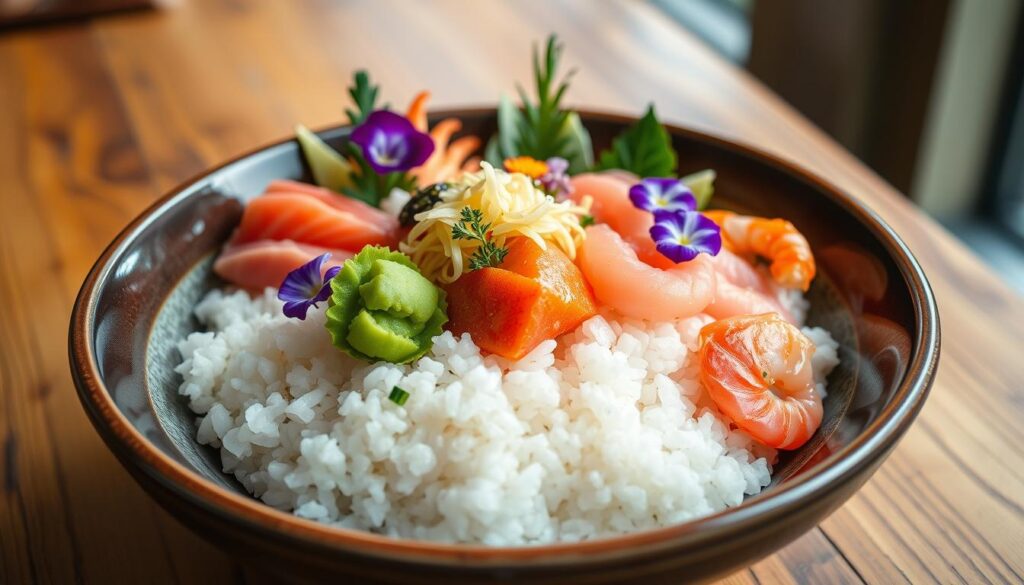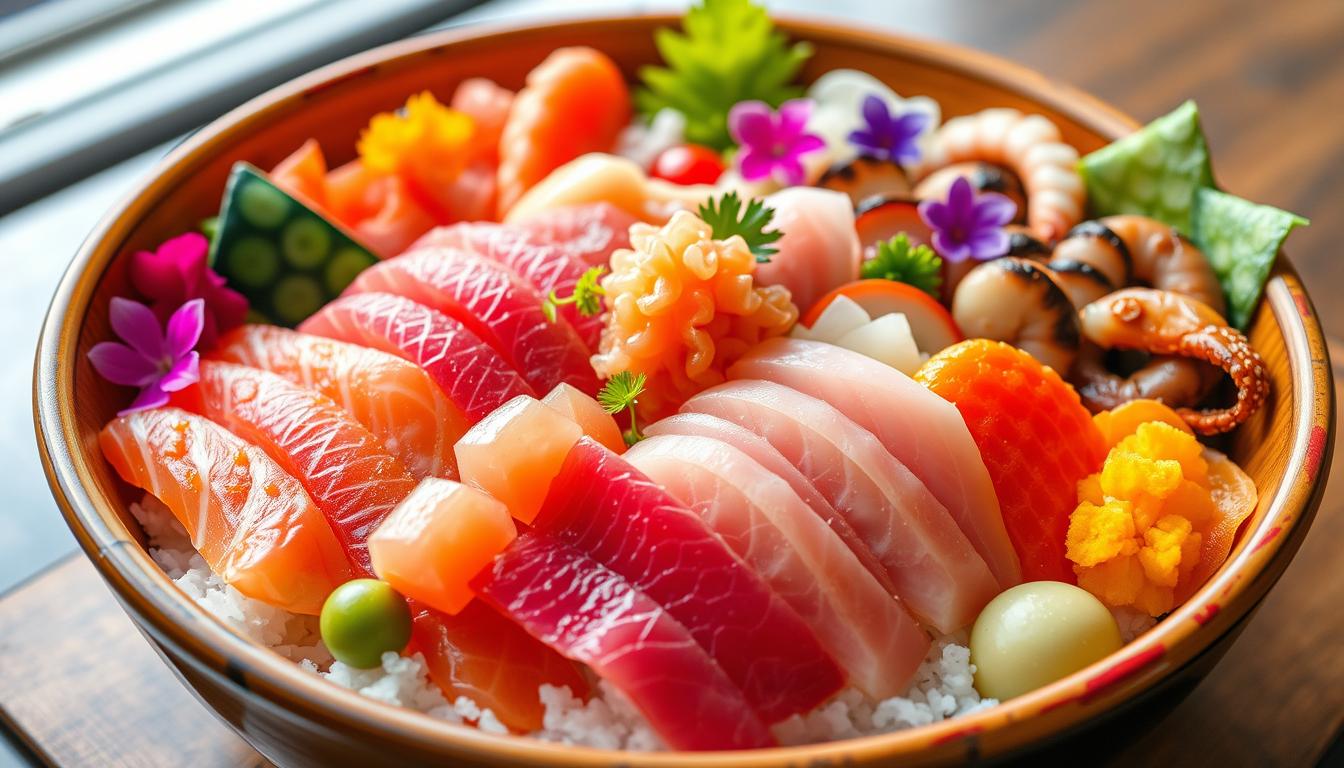Get ready to explore the world of Japanese cuisine with chirashi. This dish is like a “scattered sushi” that mixes fresh seafood delicacies with sushi rice. It’s a feast for the eyes and taste buds.
This article will take you on a journey through the history and making of this traditional Japanese food. You’ll learn about its cultural importance and how to enjoy the seafood dishes of Japan like never before.
Key Takeaways
- Chirashi is a vibrant Japanese dish that showcases a variety of fresh seafood atop seasoned sushi rice.
- This dish has a rich cultural history and is deeply rooted in Japanese culinary traditions.
- Chirashi offers a delightful sensory experience, combining visually stunning presentations with exceptional flavors.
- Exploring the regional variations of chirashi allows for a deeper appreciation of Japan’s diverse culinary landscape.
- Preparing chirashi at home can be a rewarding and enjoyable experience for food enthusiasts.
Unveiling the Essence of Chirashi
Chirashi is a Japanese rice bowl dish that celebrates fresh seafood. It’s arranged on top of seasoned sushi rice. This dish has a long history in Japan, dating back to the Edo period.
What is Chirashi?
Chirashi, also known as “scattered sushi,” is a dish that highlights Japanese cuisine. It features sushi rice topped with various seafood, like sashimi and shrimp. It also includes fried tofu pouches and colorful garnishes.
The Origins of Chirashi
Chirashi’s roots go back to the Edo period in Japan. It started as a way to use leftover sushi and sashimi. Now, it’s a unique dish known for its beauty and taste.
“Chirashi is a feast for the senses, blending the freshness of the seafood with the comforting warmth of the seasoned sushi rice.”
Today, chirashi is a favorite dish in Japan and around the world. It’s loved for its simplicity, flexibility, and the joy it brings to food lovers.

The Art of Chirashi Presentation
In Japanese food, chirashi presentation is a true art. Chefs arrange fresh seafood like fatty tuna and shrimp. They create a stunning chirashi plating display. Each piece is placed with care, using color and composition to show elegance.
The seafood arrangement in chirashi shows the chef’s skill in Japanese food aesthetics. Ingredients are arranged to balance and captivate. This turns the dish into a culinary masterpiece.
“The presentation of chirashi is as important as the ingredients themselves. It’s a delicate dance of color, texture, and balance that elevates the dining experience.”
Every detail in chirashi presentation is thought out. From fish slices to garnishes, it’s all done with precision. This creates a stunning dish that excites and amazes.

Enjoying chirashi plating in a sushi restaurant or at home celebrates Japanese cuisine. It honors the sea’s bounty with care. This turns a simple sushi bowl design into a feast for the senses.
Ingredients that Elevate Chirashi
A delicious chirashi dish starts with fresh, top-quality seafood. You’ll find tuna, salmon, yellowtail, shrimp, scallops, and fish roe in it. These are placed on sushi rice, making a dish that looks and tastes amazing.
Fresh Seafood Delicacies
The seafood in chirashi comes from Japan’s coasts and changes with the seasons. Tuna is a key ingredient, known for its rich taste. Salmon and yellowtail add sweetness and a buttery feel. Shrimp and scallops bring elegance, and fish roe adds flavor and texture.
Complementary Garnishes and Seasonings
Traditional Japanese toppings and seasonings enhance the seafood. Pickled ginger adds a refreshing zing. Nori adds a savory crunch. Soy sauce or yuzu dressing adds flavor, and wasabi adds a subtle heat.
This mix of ingredients makes chirashi more than just sushi. It’s a celebration of the sea’s bounty, showing Japanese cuisine’s artistry and detail.
“Chirashi is a symphony of flavors and textures, where each ingredient plays a vital role in creating a truly harmonious and unforgettable dining experience.”
Chirashi: A Feast for the Senses
Enjoying this dish is a treat for all the senses. It pleases your palate while captivating your eyes. The mix of flavors and textures is perfectly balanced, making each bite exciting. Its visual appeal also draws you in.
The briny sweetness of fresh seafood combines with the tangy-savory sushi rice, creating a flavor harmony that delights the taste buds. Every bite is a celebration of the sea’s offerings, with all ingredients blending seamlessly.
Visually, it’s a feast too. The vibrant colors and artistic presentation are stunning, with seafood, veggies, and garnishes creating a beautiful, edible masterpiece.
“The sensory experience of eating chirashi is truly unparalleled. It’s a dish that engages all of your senses, from the first glimpse to the final savored bite.”
Whether it’s a traditional or modern chirashi, the flavors, textures, and visual appeal are unforgettable. It shows the skill and care that Japanese cuisine is known for.
Regional Variations of Chirashi
Chirashi, a dish loved across Japan, has many regional twists. Each area brings its own flair to the dish. This shows Japan’s rich culinary diversity and the creativity of its chefs.
Exploring Japan’s Diverse Chirashi Styles
In Tokyo, you’ll find Edomae-style chirashi, all about fresh sashimi. Meanwhile, Kyoto’s version is packed with vegetables. These styles reflect the local seafood and presentation differences.
| Region | Chirashi Style | Key Ingredients |
|---|---|---|
| Tokyo (Edo) | Edomae Chirashi | Sashimi, shredded omelet, pickled vegetables |
| Kyoto | Kyoto-style Chirashi | Seasonal vegetables, tofu, mushrooms, simmered seafood |
| Osaka | Kansai-style Chirashi | Sashimi, grilled eel, avocado, crispy toppings |
| Hokkaido | Hokkaido Chirashi | Fresh seafood from the northern waters, sea urchin, salmon roe |
These regional styles highlight the unique ingredients and traditions of each area. They make the dish even more special.
The Health Benefits of Chirashi
Chirashi is not just tasty; it’s also packed with nutritional value. It’s full of fresh seafood, which is rich in omega-3 fatty acids. These acids are great for your heart and brain. Plus, the colorful veggies and seaweed add lots of essential vitamins and minerals to keep you healthy.
Chirashi is a healthy Japanese cuisine because it uses foods that are good for you. The raw fish and toppings in chirashi are full of nutrients. They help prevent diseases and make your body work better.
| Nutrient | Benefit |
|---|---|
| Omega-3 Fatty Acids | Support heart health, brain function, and reduce inflammation |
| Vitamins and Minerals | Promote immune system function, bone health, and energy production |
| Antioxidants | Protect cells from damage and reduce the risk of chronic diseases |
Adding chirashi to your meals can make them both tasty and healthy. It’s a mix of fresh seafood, colorful veggies, and tasty seasonings. This makes chirashi a special and healthy dish to enjoy.
“Chirashi is not just a feast for the senses, but also a nourishing delight for the body.”
Chirashi: A Versatile Dish for Any Occasion
Chirashi is more than just a tasty meal; it’s a dish rich in cultural traditions. The Japanese people especially love it during special occasions.
Whether it’s New Year’s or family gatherings, chirashi’s ability to use seasonal ingredients makes it a key part of Japan’s food culture.
Celebrating Traditions with Chirashi
This dish is deeply connected to the Japanese way of life. At traditional celebrations, like New Year’s, it’s a centerpiece. The seafood and colorful toppings symbolize abundance and good luck, making it ideal for welcoming the year.
It’s also special for everyday moments, as families come together to add their favorite toppings, personalizing the meal. This shared activity strengthens family bonds and celebrates Japanese traditions.
Perfect for any occasion, from big celebrations to small family dinners, the dish highlights the best of Japan’s flavors and the changing seasons, making it a true celebration of Japanese cuisine.
Where to Savor Authentic This Japanese Recipe
If you’re seeking the best, Japan’s sushi spots and specialized eateries are the places to visit. Run by expert chefs, these establishments serve top-quality dishes using the freshest seafood and traditional Japanese techniques.
Renowned Chirashi Restaurants
In Japan, you’ll find many restaurants that serve amazing chirashi. These Japanese culinary destinations are perfect for top chirashi restaurants and authentic chirashi experiences.
- Sushi Saito (Tokyo): This Michelin-starred sushi place is famous for its chirashi. It uses the freshest seafood from Tsukiji Fish Market.
- Mitch (Kyoto): In Kyoto, Mitch offers a unique omakase-style chirashi. It highlights the area’s best produce and cooking traditions.
- Uobei (Osaka): Uobei in Osaka is known for its creative chirashi. It’s a hit with both locals and tourists, offering a fun dining experience.
These are just a few of Japan’s top top chirashi restaurants. Each one provides a memorable authentic chirashi experience.
“Chirashi is a true culinary masterpiece that allows diners to savor the essence of Japan’s bountiful seafood and the artistry of its chefs.”
Recreating Chirashi at Home
Enjoying homemade chirashi at a Japanese restaurant is special. But, you can make it at home too. Learn to make sushi rice and find fresh seafood to bring chirashi recipes to your kitchen.
Making great homemade chirashi starts with the sushi rice. It’s the base for the dish’s flavors and textures. By preparing the rice right, you get the sweetness and stickiness that goes well with the seafood.
Finding fresh seafood is key for a tasty homemade chirashi. Use high-quality tuna, salmon, or shrimp. Local fishmongers or online shops can help you get the freshest seafood.
Once you have the rice and seafood, it’s time to arrange everything on a platter. This is where your creativity shines. Arrange the seafood, garnishes, and seasonings to make a beautiful homemade chirashi that will wow your guests.
Mastering sushi rice preparation, finding fresh seafood, and presentation lets you make your own chirashi recipes. Enjoy the taste of Japan in your own kitchen.
Conclusion
This Japanese dish showcases the country’s love for food and seafood. Originally a way to use leftover ingredients, it has become a favorite. It’s a mix of fresh seafood, garnishes, and seasonings that excites the taste buds.
The dish’s history and variations highlight the depth of Japanese cuisine. It’s more than just food; it’s a connection to Japan’s culture and traditions. Enjoying it allows us to appreciate the hard work and care that go into its preparation.
Today, we value such dishes more than ever. They offer a real taste of authenticity and a connection to our food. By enjoying it, we deepen our love and respect for Japanese cuisine, cherishing the traditions and flavors that make it so special.
